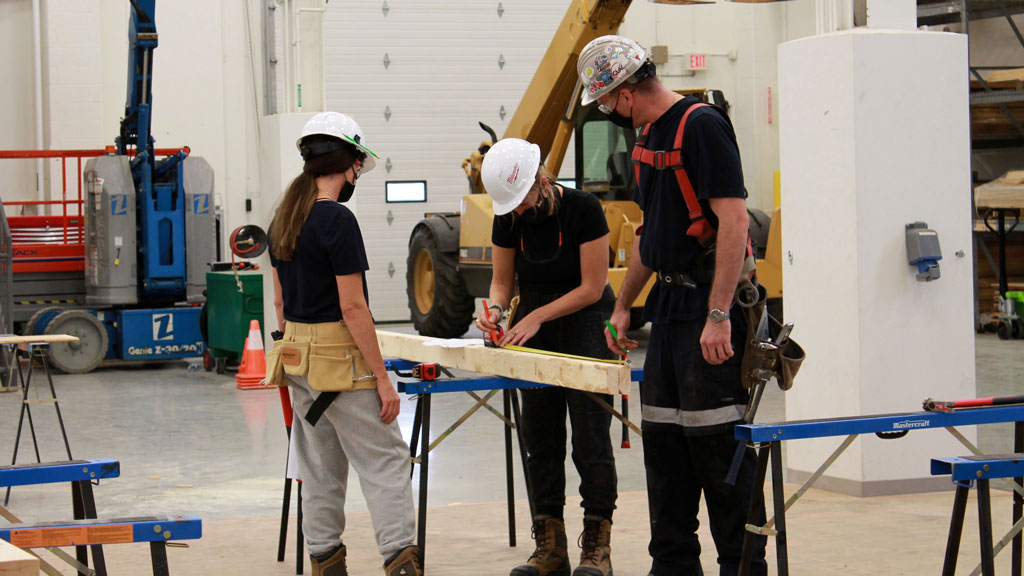When Andrew Lowry saw the list of participants in a 12-week apprenticeship course in carpentry, he was surprised by its makeup.
Even though the course is geared to underrepresented groups, he didn’t expect so many women, roughly 40 per cent of the class.
Lowry is the training co-ordinator of Carpenters’ Local 1946 in London, Ont. which held its first intake this fall of the course called Tomorrow’s Trades.
Prior to class commencement, two women were earnest about a career in the field; by the end of the course, he says, six had signed up as carpenters’ apprentices.
“As they went through the program, they saw the possibilities, they got more opportunities to do detailed work and they got into it.”
While careers in construction haven’t necessarily been on many women’s radar, with only four to five per cent of the workforce female, that might be changing.
A factor that could see those numbers rise is the changing work atmosphere.
“I don’t think there is much tolerance (on sites) for any kind of harassment or any kind of thing that would discourage women from getting into the field,” says Lowry.
He adds the healthy nature of the work and a “good pay package” are factors to attract women.
“We have a lot of bigger jobs coming up around here too, so we are looking to fill positions. There is definitely more openings for women.”
Supported by the province’s Skills Development Fund and co-ordinated in a joint venture of the Building Trades Council of Ontario and the Carpenters’ District Council of Ontario, the Tomorrow’s Trades program includes a mix of theory, demonstrations and practical.
Over the duration of its first cohort in London students erected sections of a 20-by-30-foot wood frame structure, assembled scaffolding and two seven-by-seven-foot towers which they bridged together with tube and clamp scaffolding, says Lowry.
One of the participants who went on to be a first-year apprentice and is now working with a subcontractor on the construction of a factory for Maple Leaf Foods in London is 31-year-old Julia Freeman.
She spent three years in college in interior design but the 12-week pre-apprenticeship carpentry course woke her up to what she really wanted to do.
College gave her valuable lessons in reading and completing drawings and using software programs such as AutoCAD and Autodesk Revit, but she has always liked working with her hands.
“I am a visual person, I like design…but I think I’m meant to build.”
Persuaded by her aunt to apply to the pre-apprenticeship course, 19-year-old Winter Hales was skeptical about the class, wondering if she was too young and whether she would be accepted by the male participants.
“Honestly, I thought I’d hate it and I would be one of the only women in the class.”
She was pleasantly surprised by the number of women and she took to the work quickly.
Now a first-year apprentice, Hales is employed by Big Show Scaffolding & Shrink Wrapping installing shrink wrapping on a plant being built for Amazon in St. Thomas.
“I didn’t even know what shrink wrap was but, honestly, it has been a great work experience for me.”
She says for the first two or so weeks, she “got a lot of looks” from the men unused to seeing women working on the site but her transition has been smooth.
“All of the guys have been respectful.”
Freeman, who works for Thermal Design Insulation Ltd., says while the younger male workers tend to treat women working on the project as equals, she’s capable of handling herself in awkward situations after spending years working as a server in restaurants.
Lowry says plans at Local 1946 are to hold three classes of 12 students each in the pre-apprenticeship program next year.
That might not seem like a lot, but word can spread quickly from participants to their friends about the merits of working in construction, a starting point to increasing underrepresented groups like women.
Both Freeman and Hales would recommend the course to women who like working with their hands.
“It gives you a chance to try out something over a short time without committing to college for two years…You don’t have anything to lose,” explains Freeman.
Pilots of the Tomorrow’s Trades program have also run in Ottawa, Sudbury and Hamilton.
Along with recruiting more women into the field, the objective is to attract Indigenous people, people of colour, newcomers, people with disabilities and ex-military personnel.











Recent Comments
comments for this post are closed